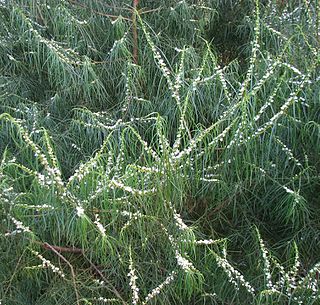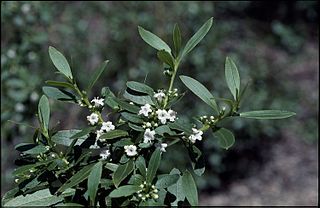
Myoporum laetum, commonly known as ngaio or mousehole tree, is a species of flowering plant in the family Scrophulariaceae and is endemic to New Zealand. It is a fast growing shrub or small tree with lance-shaped leaves, the edges with small serrations, and white flowers with small purple spots and 4 stamens.

Myoporum rapense is a plant in the figwort family, Scrophulariaceae and is endemic to French Polynesia and the Kermadec Islands. It is closely related to Myoporum laetum and there are two subspecies which are found on different island groups.

Myoporum sandwicense, commonly known as naio, bastard sandalwood or false sandalwood is a species of flowering plant in the figwort family, Scrophulariaceae. It is a tree or shrub highly variable in its form, the size and shape of its leaves, in the number of flowers in a group and in the shape of its fruit. It is endemic to Hawaiʻi.

Eremophila deserti is a shrub which is endemic to Australia. Common names for this species include turkey bush, dogwood, poison bushEllangowan poison bush, pencil bush and carrot bush. It is common and widespread in all mainland states, although not the Northern Territory. Some forms are poisonous to stock.

Myoporum insulare, commonly known as common boobialla, native juniper, is a species of flowering plant in the figwort family Scrophulariaceae and is endemic to coastal areas of Australia. It is a shrub or small tree which grows on dunes and coastal cliffs, is very salt tolerant and widely used in horticulture.

Myoporum parvifolium, commonly known as creeping boobialla, creeping myoporum, dwarf native myrtle or small leaved myoporum is a plant in the figwort family, Scrophulariaceae. It is a low, spreading shrub with long, trailing stems and white, star-shaped flowers and is endemic to southern Australia including Flinders Island.

Myoporum viscosum, commonly known as sticky boobialla, is a plant in the figwort family, Scrophulariaceae and is endemic to South Australia. It is unusual in that sometimes, especially when the leaves are crushed, it has an extremely unpleasant smell.

Sarcomelicope simplicifolia, commonly known as bauerella, hard aspen or yellow-wood, is a species of flowering plant in the family Rutaceae and is endemic to eastern Australia including Lord Howe and Norfolk Islands. It is a shrub or small tree with elliptic to egg-shaped leaves arranged in opposite pairs, male or female flowers arranged in small groups in leaf axils and fruit an oval to spherical drupe.

Myoporum petiolatum, commonly known as sticky boobialla, is a plant in the figwort family Scrophulariaceae, and is endemic to the south-east of continental Australia. For many years this species has been confused with the much less common species Myoporum viscosum from which it can be distinguished by its thinner, noticeably petiolate and non-odorous leaves.

Myoporum floribundum, commonly known as weeping myoporum or slender myoporum, is a sour-smelling glabrous shrub in the family Scrophulariaceae endemic to a small area of New South Wales and Victoria in Australia. It has long, thin, drooping leaves and profuse white flowers in clusters along the stems in spring. Although it is uncommon in nature, it has long been available as a popular garden plant.

Calystegia affinis is a critically endangered species of climbing or creeping vine in the plant family Convolvulaceae. It is endemic to Lord Howe Island and Norfolk Island. In 2003 only about 45 mature plants were known, with about 40 of those on Norfolk Island.

Myoporum montanum, commonly known as waterbush or boobialla, is a shrub native to Australia, New Guinea and Timor. The species is extremely variable in size growth habit and leaf form, with three primary forms recognised. Its occurrence in many places is restricted to coastal regions, watercourses and other locales with more reliable water supplies. It was this association with water that gave rise to the name water bush.
Dendrobium macropus, commonly known as the Norfolk Island cane orchid, is a species of epiphytic or lithophytic orchid in the family Orchidaceae and is endemic to Norfolk Island. It has cylindrical pseudobulbs, thin, dark green leaves and between five and ten yellowish green flowers that do not open widely.

Myoporum caprarioides, commonly known as slender myoporum, is a plant in the figwort family, Scrophulariaceae. It is a shrub with wart-like tubercles covering its branches and leaves, especially on the upper surface and white flowers spotted with mauve, or all blue-mauve, present for most of the warmer months.
Myoporum crassifolium is a plant in the figwort family, Scrophulariaceae. It is a shrub or small tree with thick, fleshy leaves and small groups of white flowers spotted with pink or purple. It is endemic to New Caledonia, Vanuatu and the Loyalty Islands and is a rich source of the essential oil, bisabolol.

Myoporum mauritianum is a species of flowering plant in the figwort family Scrophulariaceae and is endemic to a few volcanic islands in the Indian Ocean. It is a small, low-branched shrub with serrated leaves and small white flowers and usually grows on calcarenite within 20 metres (70 ft) of the sea.

Myoporum oppositifolium, commonly known as twin-leaf myoporum, is a plant in the figwort family, Scrophulariaceae. It is easily distinguished from others in the genus by the combination of glabrous leaves and branches, its opposite leaf arrangement and its serrated leaves. Its distribution is restricted to the extreme south-west of Western Australia.

Myoporum bontioides is a species of the flowering plant in the family Scrophulariaceae. It is a shrub growing in coastal areas of southern Japan and South China including beaches and estuaries where there are no large breaking waves.

Phreatia limenophylax, commonly known as the Norfolk Island caterpillar orchid is a plant in the orchid family, an epiphyte with four to six fleshy, channelled leaves in a fan-like arrangement. A large number of tiny white flowers are arranged along a thin flowering stem. It grows on the Solomon Islands, Norfolk Island and other islands of the southwest Pacific Ocean.
Melicope littoralis , commonly known as shade tree, is a species of shrub or small tree in the family Rutaceae and is endemic to Norfolk Island. It has trifoliate leaves and small white flowers borne in leaf axils in panicles of a few to many flowers.


















